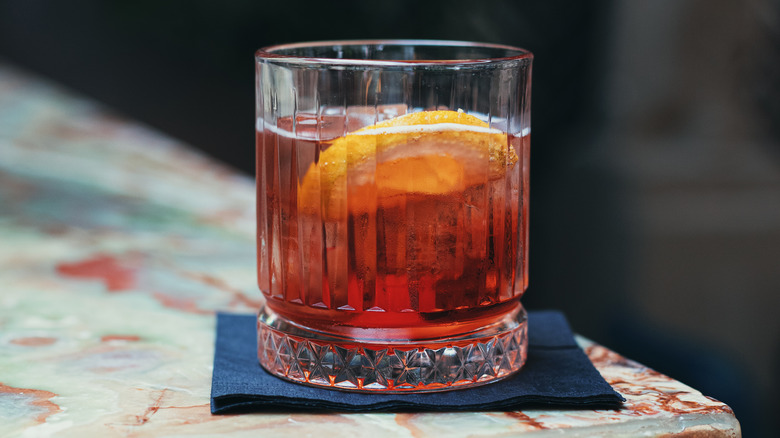The Negroni Sbagliato's Counterculture Roots
Fancy a Negroni Sbagliato? You aren't the only one! Given the recent popularity of bitter beverages, Bar & Restaurant shares that the old-school Negroni (and all its variations) is once again becoming a favorite among the masses — especially, within the under-35 demographic. Meeting demand for less-than-sweet cocktails, the Sbagliato has seen a revival following its praise from celebrities like "House of the Dragon" star Emma D'Arcy. However, you might be surprised to learn about the cocktail's counterculture roots.
A twist on the classic Negroni (made with equal parts of Campari, vermouth, and gin), the Negroni Sbagliato is instead crafted with one ounce of Campari and one ounce of sweet red vermouth that's topped off with dry sparkling wine and garnished with an orange peel. Somewhere in between a light and fizzy Aperol spritz and a punchy Negroni, the Sbagliato maintains bitter complexity but is significantly easier to sip given its lower alcohol content thanks to a splash of effervescent vino.
With over a century of history, it's no wonder that endless riffs beyond the Sbagliato have since been inspired. According to Liquor.com, there's the White Negroni made with French aperitif and blanc vermouth, the Mezcal Negroni that provides a smoky swap for gin, or the coffee-infused Cold-Brew Negroni — there's even the Negroni predecessor, the Americano, made with Campari, sweet vermouth, and soda water. However, the Negroni Sbagliato remains one derivative that's especially important because of its unique origins that came to define an age of modernity and rebellion.
A not-so accidental mistake
A Made-in-Milano tipple, Bloomberg explains that while sbagliato may translate into "mistaken," the creation of the cocktail in the 1970s was anything but an accident. Rather than confuse a bottle of Prosecco for gin when crafting a Negroni at Bar Basso — as the tale so often goes — the swap was likely intentional, gaining popularity with a new generation of drinkers thanks to its catchy name.
Transforming from a poor and agrarian society into a more economically and socially advanced country, Britannica explains that during the late 1960s, Italy was becoming increasingly contemporary — university students protested against the taught ideologies relating to the church and family, the government legalized contraception and divorce, and more women were able to gain an education and enter the workforce, especially in Milan's fashion industry.
In an interview for Slate, the son of Mirko Stocchetto (the Negroni Sbagliato's inventor) explained that with working women beginning to participate in social life and frequent bars, Stocchetto began developing a flurry of new and lighter tipples that swapped liquors for wine, pioneering the Negroni Sbagliato. Not to be confused with the result of a clumsy mistake, Stocchetto decided to name the cocktail as such as a marketing tactic to attract interest among the clientele — a tactic that proves to still be successful.

